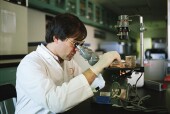A new type of sensor for people with diabetes is being developed to measure sugar levels in the body using saliva instead of blood, researchers report.
Scientists at Brown University in Providence, R.I., created the sensor and successfully tested it using artificial saliva. It uses light, metal and a special enzyme that changes color when exposed to blood sugar.
“Everybody knows that diabetics have to prick their fingers to draw blood to check their blood sugar and then respond to that information. And they have to do that multiple times a day,” said study co-author Tayhas Palmore, a professor of engineering, chemistry and medical science at Brown.
“We’re looking for another possibility, and realized that saliva is another bodily fluid that could be measured,” Palmore said.
This idea is a welcome one, said Dr. Joel Zonszein, director of the Clinical Diabetes Center at Montefiore Medical Center in New York City. “People are always trying to come up with new ideas of how to measure blood sugar without pricking the fingers.”
The sensor won’t be available anytime soon, however. “The process of [U.S. Food and Drug Administration] approval will take a long time, and we have to see how accurate this device is in humans, especially humans who are eating and drinking, which will possibly contaminate the sample,” Zonszein said.
Findings from the study, which received funding from the National Science Foundation, were published recently in the journal Nanophotonics.
To check their blood sugar — or glucose — levels, people with diabetes — especially those who need insulin — must prick one of their fingers to draw a drop of blood. The blood is put on a test strip that goes into a blood sugar meter. They are supposed to repeat this procedure four times a day, according to the American Diabetes Association.
The results of the blood sugar tests guide treatment, with diabetes patients often adjusting medication or insulin levels based on the test reading to maintain acceptable glucose levels.
The Brown researchers realized that saliva also contains glucose, though in much lower quantities.
Continued
The new device uses light and a metal surface that interferes with the way light hits a sample, Palmore said. The light “reads” how a special enzyme reacts to the presence of sugar in saliva to measure the concentration of sugar in a sample.
The researchers tested the sensor on artificial saliva to see how well it works without the potential complications found in real saliva. For example, food or drinks could alter the results. The sensor was able to detect sugar levels with high accuracy, they said.
Palmore said the next step is to make the device portable, hopefully small enough to fit in your hand. They also need to test it on real saliva, and find inexpensive light sources. Palmore said the researchers are also working on ways to measure insulin levels in the body.
Some sort of rinse for use before testing a saliva sample is also needed. A mouthwash could remove food or other contaminants that might affect the glucose reading, according to Palmore.
“Just because there is an established way of measuring blood sugar, doesn’t mean it’s the only way,” said Palmore. “This is a priority area of research for many people. There’s some hope that you may not have to prick yourself every couple of hours.”
Zonszein added that the idea of searching for alternatives is a good one. “But to apply that from the lab to human clinical trials is still very far away,” he said.
Sources
SOURCES: Tayhas Palmore, Ph.D., professor, engineering, chemistry and medical science, Brown University School of Engineering, Providence, R.I.; Joel Zonszein, M.D., director, Clinical Diabetes Center, Montefiore Medical Center, New York City; June 2014 Nanophotonics
